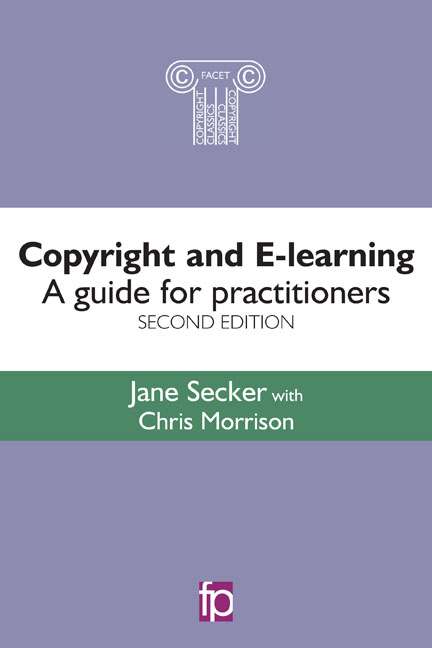Book contents
- Frontmatter
- Contents
- Figures, tables and case studies
- Preface to the second edition
- Introduction
- Abbreviations and acronyms
- Glossary
- 1 E-learning and copyright: background
- 2 Digitizing text-based content for delivery in a VLE
- 3 Using digital media: video, images, sound and software
- 4 Copyright issues and born digital resources
- 5 Copyright in the connected digital environment
- 6 Copyright education and training
- 7 Conclusion
- Further resources
- Index
5 - Copyright in the connected digital environment
Published online by Cambridge University Press: 08 June 2018
- Frontmatter
- Contents
- Figures, tables and case studies
- Preface to the second edition
- Introduction
- Abbreviations and acronyms
- Glossary
- 1 E-learning and copyright: background
- 2 Digitizing text-based content for delivery in a VLE
- 3 Using digital media: video, images, sound and software
- 4 Copyright issues and born digital resources
- 5 Copyright in the connected digital environment
- 6 Copyright education and training
- 7 Conclusion
- Further resources
- Index
Summary
Introduction
The internet and associated web-based technologies have developed significantly over the last decade, with a seemingly constant stream of new tools to facilitate communication and interactivity. At the same time we have also seen the devices we use to connect to internet services become significantly more sophisticated and embedded in our daily lives. There has also been a shift towards cloud computing services where data processing and storage takes place on the network rather than on the local device. This has been made possible by the increased availability and a reduction in cost of high-speed broadband networks. Recent Ofcom statistics showed that broadband access in the home in the UK grew from 13% in 2003 to 87% in 2015 (Ofcom, 2015). Increased connectivity has changed the ways in which learning can be delivered to students, so anytime, anywhere learning is becoming a real possibility in much of the UK.
This chapter focuses on current internet technologies being used in education, and the associated copyright issues. The terminology used to describe these technologies can be problematic as any attempt to categorize developments in such a fast moving environment tends to sound out of date relatively quickly. The term ‘Web 2.0’, which started to be used after 2004, was intended to describe the development from a read-only web of static pages to one that was inherently interactive, but was immediately criticized by many (including Sir Tim Berners Lee, the inventor of the world wide web) for being too vague or potentially misleading (Naughton, 2012). Similarly, ‘mobile technology’ and ‘cloud computing’ were buzz words in 2009 when the first edition of this book was written, but in the intervening years the technologies have become so well established that they no longer seem that remarkable. However, despite the issues with shifting terminology it is clear that digitally connected tools such as blogs, wikis, apps, social media and social networking services share certain characteristics and have transformed the way that people access information, communicate and interact with the wider world. The focus here is not on these technologies per se, but on any specific copyright questions that arise from their use in an educational context. Suggested further resources are included at the end of the book; for example, Cornish (2015, 176–9) examines some of the copyright issues associated with social media services.
- Type
- Chapter
- Information
- Copyright and E-learninga guide for practitioners, pp. 163 - 210Publisher: FacetPrint publication year: 2016



